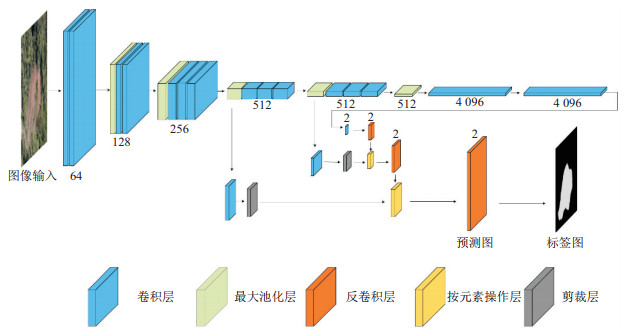Optimization of the landslide identification method based on a dual attention mechanism
-
摘要: 随着计算机视觉技术的发展, 通过卫星图像深度学习进行滑坡识别的研究正在逐步展开。通过引入双重注意力机制, 提出了一种基于卷积神经网络的滑坡图像识别优化算法。基于统计的2 200张滑坡图像数据集, 探讨了10种网络结构及4种注意力机制对滑坡识别结果的影响, 并通过比例为4∶1的训练集和测试集进行滑坡识别, 验证了本文方法的有效性。结果表明: ResNet结构相较于其他网络结构表现更为优秀, 就该算例而言, ResNet-101结构具有最高的召回率、精确率和F1度量。融入了双重注意力机制的卷积神经网络相较于单个神经网络而言, 滑坡识别的精确率更大, 且滑坡边界分割结果更接近于真实的滑坡边界, 其中, ResNet-101+DAN模型为最优模型。相较之下, 单个神经网络无法克服图像噪声的影响, 图像分割结果不佳。Abstract: With the development of computer vision technology, studies on landslide identification have gradually been carried out by means of deep learning. By introducing the dual attention model, an optimization algorithm for landslide image recognition based on a convolutional neural network is proposed in this paper. Based on 2 200 landslide image datasets, this paper discusses the effects of 10 network structures and 4 attention models on landslide recognition results. The effectiveness of this method is verified by using a 4∶1 training set and test set for landslide recognition. The results show that the ResNet structure performs better than other network structures. For this example, the ResNet-101 structure has the highest recall rate, precision rate and F1-measure. Compared with a single neural network, the convolutional neural network with a dual attention model has a higher accuracy of landslide identification, and the segmentation result of the landslide boundary is closer to the real landslide boundary. Among them, the ResNet-101+DAN model is the optimal model. In contrast, a single neural network cannot overcome the influence of the image noise, and the result of the image segmentation is poor.
-
表 1 开源数据对比结果
Table 1. Comparison results of open data
网络结构 均交并比(MIoU) FCN 61.23 DeepLab-v2 70.32 ResNet50 73.27 PSPNet+Res101 77.48 DANet+Res101 79.76 表 2 不同网络架构的预测结果
Table 2. Prediction results of different network architectures
序号 网络结构 精确率
(Precision)召回率
(Recall)F1度量
(F1-measure)均交并比
(MIoU)1 VGG-13 0.921 0.913 0.917 0.663 2 VGG-16 0.933 0.894 0.913 0.705 3 VGG-19 0.918 0.872 0.894 0.652 4 ResNet-18 0.946 0.896 0.920 0.716 5 ResNet-50 0.937 0.902 0.919 0.711 6 ResNet-101 0.949 0.915 0.932 0.731 7 Inception-v3 0.941 0.912 0.926 0.737 8 DenseNet-121 0.963 0.852 0.904 0.723 9 DenseNet-169 0.932 0.873 0.902 0.697 10 DenseNet-201 0.923 0.903 0.913 0.743 表 3 不同方法实验结果对比
Table 3. Comparison of experimental results of different methods
网络结构 精确率(Precision) 召回率(Recall) F1度量(F1-measure) 均交并比(MIoU) 检测速度/(帧·s-1) ResNet-101 0.949 0.915 0.917 0.731 14.0 ResNet-101+SE 0.952 0.917 0.934 0.763 11.3 ResNet-101+BAM 0.954 0.920 0.937 0.796 12.8 ResNet-101+CBAM 0.961 0.923 0.942 0.787 11.5 ResNet-101+DAN 0.964 0.952 0.958 0.802 13.6 表 4 不同类型滑坡计算结果的对比
Table 4. Comparison of calculation results of different types of landslides
滑坡类型 精确率
(Precision)召回率
(Recall)F1度量
(F1-measure)均交并比
(MIoU)有植被覆盖土质滑坡 0.951 0.963 0.957 0.830 无植被覆盖土质滑坡 0.932 0.897 0.914 0.782 有植被覆盖岩质滑坡 0.974 0.921 0.947 0.812 无植被覆盖岩质滑坡 0.923 0.903 0.913 0.776 -
[1] 黄润秋. 20世纪以来中国的大型滑坡及其发生机制[J]. 岩石力学与工程学报, 2007, 26(3): 433-454. doi: 10.3321/j.issn:1000-6915.2007.03.001Huang R C. Large scale landslides and their occurrence mechanism in China since the 20th century[J]. Chinese Journal of Rock Mechanics and Engineering, 2007, 26(3): 433-454(in Chinese with English abstract). doi: 10.3321/j.issn:1000-6915.2007.03.001 [2] 陈红旗. 贵州纳雍张家湾普洒村山体崩塌[J]. 中国地质灾害与防治学报, 2018, 29(1): 22. https://www.cnki.com.cn/Article/CJFDTOTAL-ZGDH201801025.htmCheng H Q. Mountain collapse in Pusa Village, Zhangjiawan, Nayong, Guizhou[J]. The Chinese Journal of Geological Hazard and Control, 2018, 29(1): 22(in Chinese with English abstract). https://www.cnki.com.cn/Article/CJFDTOTAL-ZGDH201801025.htm [3] 陈红旗. 四川茂县"6·24"特大山体滑坡灾害[J]. 中国地质灾害与防治学报, 2017, 28(3): 51. https://www.cnki.com.cn/Article/CJFDTOTAL-ZGDH201703026.htmCheng H Q. "6.24" landslide disaster in Maoxian County, Sichuan Province[J]. The Chinese Journal of Geological Hazard and Control, 2017, 28(3): 51(in Chinese with English abstract). https://www.cnki.com.cn/Article/CJFDTOTAL-ZGDH201703026.htm [4] 张卫雄, 翟向华, 丁保艳, 等. 甘肃舟曲江顶崖滑坡成因分析与综合治理措施[J]. 中国地质灾害与防治学报, 2020, 31(5): 7-14. https://www.cnki.com.cn/Article/CJFDTOTAL-ZGDH202005002.htmZhang W X, Zhai X H, Ding B Y, et al. Causative analysis and comprehensive treatment of the Jiangdingya landslide in Zhouqu County of Gansu Province[J]. The Chinese Journal of Geological Hazard and Control, 2020, 31(5): 7-14(in Chinese with English abstract). https://www.cnki.com.cn/Article/CJFDTOTAL-ZGDH202005002.htm [5] Bellotti F, Bianchi M, Colombo D, et al. Advanced InSAR techniques to support landslide monitoring[C]//Anon. 15th Annual Conference of the International Association of Mathematical Geosciences. [S.l.]: [s.n.], 2013: 287-290. [6] Escanoglu M, Gokceoglu C. Assessment of landslide susceptibility for a landslide-prone area(north of Yenice, NW Turkey)by fuzzy approach[J]. Environmental Geology, 2002, 41(6): 720-730. doi: 10.1007/s00254-001-0454-2 [7] 胡涛, 樊鑫, 王硕, 等. 基于逻辑回归模型和3S技术的思南县滑坡易发性评价[J]. 地质科技通报, 2020, 39(2): 113-121. https://www.cnki.com.cn/Article/CJFDTOTAL-DZKQ202002013.htmHu T, Fan X, Wang S, et al. Landslide susceptibility evaluation of Sinan County using logistics regression model and 3S technology[J]. Bulletin of Geological Science and Technology, 2020, 39(2): 113-121(in Chinese with English abstract). https://www.cnki.com.cn/Article/CJFDTOTAL-DZKQ202002013.htm [8] Kayastha P, Dhital M R, Smedt F D. Application of the analytical hierarchy process(AHP) for landslide susceptibility mapping: A case study from the Tinau watershed, west Nepal[J]. Computers & Geosciences, 2013, 52(3): 398-408. [9] Althuwaynee O F, Pradhan B, Lee S. Application of an evidential belief function model in landslide susceptibility mapping[J]. Computers & Geosciences, 2012, 44: 120-135. https://www.sciencedirect.com/science/article/pii/S009830041200091X [10] Komac M. A landslide susceptibility model using the analytical hierarchy process method and multivariate statistics in perialpine Slovenia-Science Direct[J]. Geomorphology, 2006, 74(1): 17-28. https://www.sciencedirect.com/science/article/pii/S0169555X05002072 [11] Lee S. Application and verification of fuzzy algebraic operators to landslide susceptibility mapping[J]. Environmental Geology, 2007, 52(4): 615-623. doi: 10.1007/s00254-006-0491-y [12] Marjanovi M, Kovaevi M, Bajat B, et al. Landslide susceptibility assessment using SVM machine learning algorithm[J]. Engineering Geology, 2011, 123(3): 225-234. doi: 10.1016/j.enggeo.2011.09.006 [13] 黄发明, 胡松雁, 闫学涯, 等. 基于机器学习的滑坡易发性预测建模及其主控因子识别[J/OL]. 地质科技通报: 1-12[2021-09-30]. https://doi.org/10.19509/j.cnki.dzkq.2021.0087.Huang F M, Hu S Y, Yan X Y, et al. Landslide susceptibility prediction and its main environmental factors identification based on machine learning models[J/OL]. Bulletin of Geological Science and Technology: 1-12[2021-09-30]. https://doi.org/10.19509/j.cnki.dzkq.2021.0087(in Chinese with English abstract). [14] 郑迎凯, 陈建国, 王成彬, 等. 确定性系数与随机森林模型在云南芒市滑坡易发性评价中的应用[J]. 地质科技通报, 2020, 39(6): 131-144. https://www.cnki.com.cn/Article/CJFDTOTAL-DZKQ202006015.htmZheng Y K, Chen J G, Wang C B, et al. Application of certainty factor and random forest model in landslide susceptibility evaluation in Mangshi City, Yunnan Province[J]. Bulletin of Geological Science and Technology, 2020, 39(6): 131-144(in Chinese with English abstract). https://www.cnki.com.cn/Article/CJFDTOTAL-DZKQ202006015.htm [15] Hong Y, Yi M, Wang L, et al. A landslide intelligent detection method based on CNN and RSG_R[C]//Anon. IEEE International Conference on Mechatronics & Automation. [S.l.]: IEEE, 2017: 40-44. [16] Lecun Y, Bengio Y, Hinton G. Deep learning[J]. Nature, 2015, 521: 436-444. https://www.nature.com/articles/nature14539 [17] He K, Zhang X, Ren S, et al. Deep Residual learning for image recognition[C]//Anon. 2016 IEEE Conference on Computer Vision and Pattern Recognition(CVPR). [S.l.]: IEEE, 2016: 770-778. [18] Ren S Q, He K M, Girshick R, et al. Faster R-CNN: Towards real-time object detection with region proposal networks[J]. IEEE Transactions on Pattern Analysis and Machine Intelligence, 2017, 39(6): 1137-1149. doi: 10.1109/TPAMI.2016.2577031 [19] Chen L C, Papandreou G, Kokkinos I, et al. DeepLab: Semantic image segmentation with deep convolutional nets, atrous convolution, and fully connected CRFs[J]. IEEE Transactions on Pattern Analysis and Machine Intelligence, 2018, 40(4): 834-848. https://arxiv.org/abs/1606.00915 [20] Ding A, Zhang Q, Zhou X, et al. Automatic recognition of landslide based on CNN and texture change detection[C]//Anon. 201631st Youth Academic Annual Conference of Chinese Association of Automation(YAC). [S.l.]: IEEE, 2016: 444-448. [21] Ghorbanzadeh O, Blaschke T, Gholamnia K, et al. Evaluation of different machine learning methods and deep-learning convolutional neural networks for landslide detection[J]. Remote Sensing, 2019, 11(2): 196-216. https://www.researchgate.net/publication/330514716_Evaluation_of_Different_Machine_Learning_Methods_and_Deep-Learning_Convolutional_Neural_Networks_for_Landslide_Detection [22] Jie H, Li S, Gang S, et al. Squeeze-and-excitation networks[J]. IEEE Transactions on Pattern Analysis and Machine Intelligence, 2017, 42(8): 2011-2023. https://ieeexplore.ieee.org/document/8701503/ [23] Park J, Woo S, Lee J Y, et al. BAM: Bottleneck attention module[C]//Anon. British machine vison conference. Berlin: BMWC, 2018: 147-160. [24] Woo S, Park J, Lee J Y, et al. Cbam: Convolutional block attention module[C]//Anon. Proceedings of the European Conference on Computer Vision(ECCV). [S.l.]: [s.n.], 2018: 3-19. [25] Fu J, Liu J, Tian H, et al. Dual attention network for scene segmentation[C]//Anon. 2019 IEEE/CVF Conference on Computer Vision and Pattern Recognition(CVPR). [S.l.]: IEEE, 2020: 3141-3149. [26] Simonyan K, Zisserman A. Very deep convolutional networks for large-scale image recognition[J]. arXiv preprint arXiv: 1409.1556, 2014. [27] Evan S, Jonathan L, Trevor D. Fully convolutional networks for semantic segmentation[J]. IEEE Transactions on Pattern Analysis and Machine Intelligence, 2017, 39(4): 640-651. https://pubmed.ncbi.nlm.nih.gov/27244717/ [28] 王赛. 基于多源遥感数据的汶川地震型滑坡信息提取研究[D]. 北京: 中国地质大学(北京), 2015.Wang S. Research on earthquake-induced landslide extraction from multi-source remote sensing data in the Wenchuan[D]. Beijing: China University of Geosciences(Beijing), 2015(in Chinese with English abstract). [29] Szegedy C, Vanhoucke V, Ioffe S, et al. Rethinking the inception architecture for computer vision[C]//Anon. 2016 IEEE Conference on Computer Vision and Pattern Recognition(CVPR). [S.l.]: IEEE, 2016: 2818-2826. [30] Zhao H, Shi J, Qi X, et al. Pyramid scene parsing network[C]//Anon. 2017 IEEE Conference on Computer Vision and Pattern Recongnition(CVPR). [S.l.]: IEEE, 2017: 6230-6239. [31] He K, Zhang X, Ren S, et al. Deep residual learning for image recognition[C]//Anon. 2016 IEEE Conference on Computer Vision and Pattern Recognition(CVPR). [S.l.]: IEEE, 2016: 770-778. [32] Huang G, Liu Z, Laurens V, et al. Densely connected convolutional networks[C]//Anon. IEEE Conference on Computer Vision and Pattern Recognition(CVPR). [S.l.]: IEEE, 2017: 2261-2269. -





 下载:
下载:








